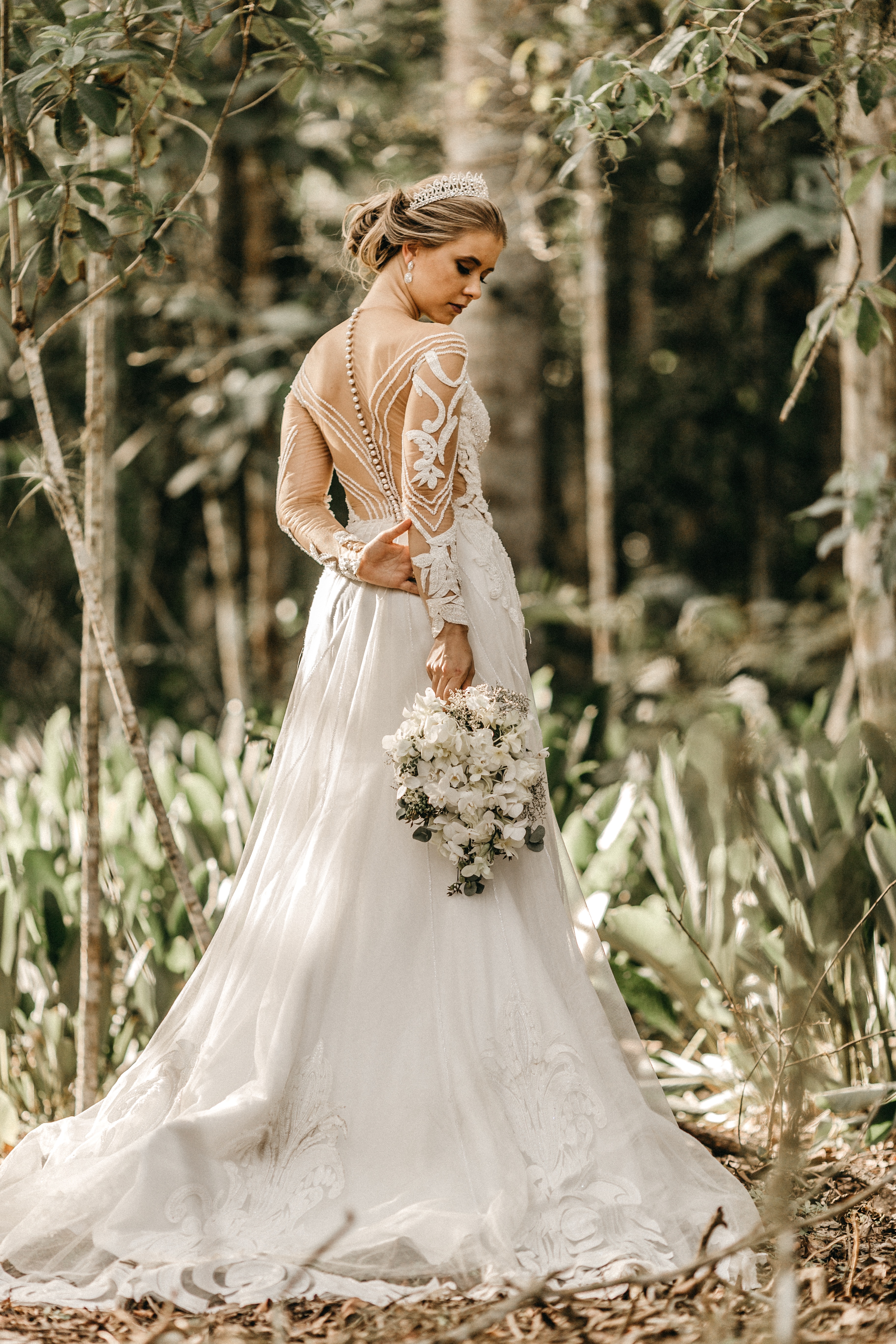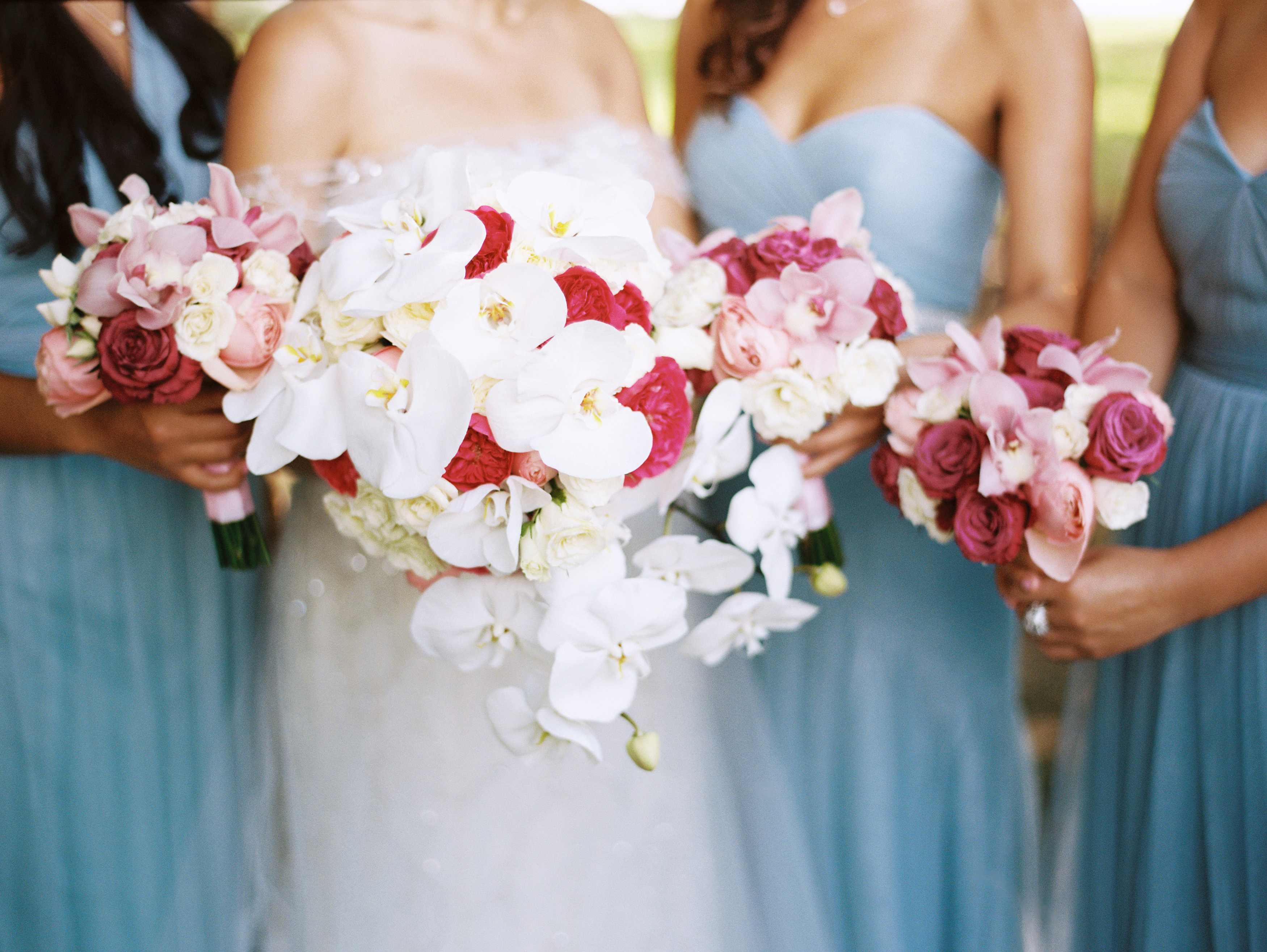This entry is from our Expert Guest series where wedding and honeymoon professionals share their best tips on creating memories that last a lifetime.
When you choose your wedding dress, it is really helpful to have some knowledge about fabrics and materials. Thorough research will show you the options in your price range as well as what you can expect from each beautiful wedding dress fabric.
Seriously… brides to be, it pays to just have a little bit of knowledge about materials – not necessarily indicate what is good and what is bad. It’s not that simple, but what do different qualities do when they are used in a dress?
Silk vs. Polyester
One classic mistake is that anything “silky” is silk. That is not so. Silk is a beautiful fibre, spun by silkworms before they become butterflies; they have been farmed for thousands of years for their amazing ability to make a beautiful thread. There are a few “wild” butterflies, which still makes a silk thread with a different character to the farmed silk butterfly, such as Shantung, and Tussah.
Silk has always been an expensive material, but in recent years prices have soared. As a result, most wedding dresses today are made in polyester. There is absolutely nothing wrong with polyester wedding dresses, but I would like you to know what you are buying. Be careful as some shops sell the polyester dresses as silk because they are “silky” or spelling “shantung” in a different way, to confuse.
Most silk is smooth, but one of the silks commonly used is Dupioni silk or Orissa silk; it has a “slub” a thicker thread which makes little knots and imperfections on the thread running horizontally. In this case, I hate the polyester version, and will not work in it. I feel it looks cheap and also think that imitating nature is always a fail. (Imagine humans spinning a cobweb?)
Choosing Your Weave
Along with the fibre that the fabric is woven from, the actual weave also makes a difference. Satin is a type of weave which makes a shiny, smooth surface, as either four or more horizontal or weft yarns are floated over one longitudinal or warp yarn or the pattern is reversed so that the number of warp yarns predominates. Whether the fabric itself is wool, cotton, silk, or polyester, the result is fabric with an excellent ability to drape. In satin, we have both thick hard/stiff satins called Duchesse satins, and slinky satins, with different names such as crepe back satins, camisole silk, slipper silk and more. The Duchesse satin is much used in stiffer more formal gowns like 1940s gowns, and the softer ones are more like styles from the 20s, soft slinky, sitting close to the body. The silk satins are about 8 times the price of the polyesters.
Many fabrics used in wedding gowns are made using a plain weave, which means that the warp (longitudinal) and weft (horizontal) threads cross at right angles so that the result is a cross-stitch pattern. Materials using this type of weave include sheers such as chiffon, georgette, and organza.
Sheers And More
Of the sheers, of the most popular is the chiffon, which we can get that in both silk and polyester. Many people can’t tell the difference between a chiffon and a georgette, as they are both sheer and soft, but a chiffon is smooth and a georgette is textured and slightly matter. Then there is organza. Organza is also transparent but stiff. Allegedly, it’s the glue from the silk cocoon that fives the stiffness to the material. I love organza; I feel you can get the sheer look but crisp, with some structure. It’s a lighter weight of the silk Ghazaar which has been out of fashion for ages but made a strong came back when Kate Middleton’s designer used it for her dress.
Apart from those already mentioned, we have taffeta, which is a hard crisp plain weave shiny material; it has had a bad name for years due to Fergie’s wedding dress (assumed to be taffeta but actually Duchesse satin). Lots of people say it looks creased, but I like it the kind of crease it assumes, a bit like a piece of paper. A heavier version of taffeta is called Poult. It’s great for ruching and folding, and origami-style detailing.
Then we have all the crepes. They are matte materials, with a texture. When the crepes are silk they are often called Marocain’s, and sometimes have a kind of peach skin or sand washed finish. All those matte materials have been used a lot for more understated wedding dresses like Meghan Markle’s dress. Crepe always drapes and hangs softly. Wool crepe is lovely and occasionally used for wintry wedding dresses.
Another choice is tulle, which is just French for netting. You know those – usually, a stiffer version is used for big princess dresses, but you also get softer tulles like the ones designers like Jenny Peckham does heavy bead embroidery on or those like Claire Pettibone use with embroidery on top.
Beautiful Wedding Laces
Ohh and then the laces!… where do we start? Most laces today are actually not true laces, but tulle with embroidery. The embroidered tulle usually are more cost-efficient and can be made in wider widths than the traditional laces, so if you have a dress with wide panels, then often the lace will be embroidered tulle.
There is also Chantilly lace, which in my eyes is the most beautiful lace. This handmade “bobbin lace” made by braiding and twisting lengths of thread wound on bobbins to manage them during production has plentiful detail. Usually it only comes in very narrow pieces, so it more suitable for the bodices or straighter dresses. You will need lots and lots for a dress in panels, which makes pricey.
Another choice is Guipore, a bigger heavier lace that can also be made in different fibres. The more expensive ones are silk wool or viscose – a cellulose fibre, in theory the same as a Kleenex tissue, and quite fragile when wet, but beautiful and glossy and rich. Guipure has been much in fashion from European fashion houses recently, and the results are stunning. Guipure is also great for a slightly 1960 and 1970s feel.
Sometimes a dress has more than one lace on it. This technique of layering is very much in fashion at the moment. Usually, it’s with something like a fine Chantilly on the main part of the dress and then a heavier lace with scallop edges (that curvy edge good quality lace has) Really good scallops have little fluttery bits called eyelashes – I love them! Sometimes laces are corded, which means a thicker thread, sometimes a shiny thread or a slightly darker thread goes round the design to emphasize the pattern. Some laces have also soft tulle rose petals and similar on top to give a 3D kind of feel to the dress and makes it soft and fluttery.
Occasionally a wedding dress is a “knitted” dress, which means instead of a woven dress, the thread has been knitted on a big machine, it’s also called jersey. They are usually silk or viscose dresses; such designers as Amanda Wakely and Alice Temperley have made this popular. Be aware these dresses fit really close to the body and are very revealing.
Choosing The Right Wedding Dress Fabric For Your Gown
I think you should decide what is important to you. Clearly, in a wedding dress the labour makes up most of the cost, so I think you should go for the most expensive material you can afford. If you are having a bespoke dress, it makes absolute sense to go for silk. I have some clients who come into the shop and say “I can’t see the difference between the silk and the polyester.” Well, if that is the case, hold on to your money and choose polyester.
I think the colours are a bit nicer in natural fibres fabrics compared to manmade fibres. Also, I feel the colours are kinder and more natural. The manmade fibres are dyed with chemical dyes, and I feel that shows.
There is, as many of you will know, a controversial side of silk production. Silk has been produced for thousands of years, and in the process of producing the silk, the silkworms die. That is obviously not great, and therefore, Vegans tend to avoid silk. If you chose to go for silk, my advice is to check where it comes from and check that the silks are from a “fair-trade” producer, where I am pleased to say that the money goes back into the communities producing the silks.
While I know the price is always a concern, but it would ruin my wedding day if I had not carried out the full research of where my dress came from. Many wedding dresses are produced under bad conditions in sweatshops around the world. So perhaps, before you place your order for your wedding dress, ask your supplier where it came from, and under which conditions it has been produced.
With many fabrics to choose from, there are many ways to look beautiful on your wedding day. With a little fabric knowledge, you can achieve the look you want.
Make your wedding dreams come true with a Honeyfund honeymoon registry.
Bio: Blog by Mette Baillie, Freja Designer Dressmaking, Edinburgh Scotland.





















And its really well written, thanks for sharing the information in such a beautiful and well formatted manner.
Thanks for the inspiroraton https://get-tubemate.in
I had spent a lot of time to choose my wedding dress… This is really nice guide.